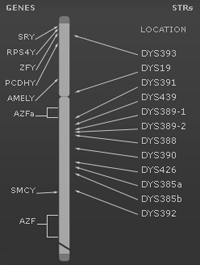Macro-genealogy

A little while ago I posted the results of my participation in the Genographic Project, a comprehensive attempt to fill the holes in our knowledge of human migratory patterns around the globe based on genetic evidence. I just finished Spencer Wells’s short, accessible introduction to this topic and, coincidentally, spent a 14-hour plane flight sitting next to the producer of a documentary who is using this data to help African-Americans determine their home areas in Africa in the absence of genealogical information. (Sitting next to him wasn’t coincidence; he’s with me on business. That we’re both interested in population genetics is coincidence.) So I understand things a lot better now.
The first realization is how incomplete the picture is. The Genographic Project looks for markers (chromosomal mutations passed on from generation to generation) in the Y chromosome for men and in mitochondrial DNA for women. What this means is that my information only reflects my lineage via my father and his father and his father and so on (called the “patrilineal line”). At the very least I’m missing the story from my other three grandparents. Three of them are deceased, but luckily I have relatives who can be tested.
Here’s what I know so far. My patrilineal line comes from the second migration of modern humans out of east Africa after what is known as The Great Leap Forward, an evolutionary moment where homo sapiens, through a truly lucky genetic mutation, acquired long-term memory, which allowed for the development of language (since thoughts could be strung together linearly), and thus to the ability to think more complexly. They made their way to Mesopotamia over the millennia and then 10,000 to 15,000 years ago my people — my exact line descended from a single person — were the instigators of what is is called the Neolithic Revolution, the birth of agriculture. My ancestors were the first farmers. They were the peoples who expanded into southern Europe and northern Africa, literally sowing the seeds of modern society.
The marker that denotes all this is called M172. It is relatively rare in Europe, occuring in only 20% of peoples in southern Italy; 10% in Spain. My ancestors were sedentary and Meditteranean-hugging. Somehow agriculture was transmitted via this line to the rest of Europe. (How this happened exactly is hotly debated.) If this isn’t fascinating, I’m hard-pressed to describe to you something else that is.
But, again, this is only my Dad’s male line. There’s more to be learned. For instance, my paternal grandmother has always said there is Native American blood in her. This test will prove or disprove that right away.
Get ready, Grandma, cheek swab incoming!














Interestingly I also did the genographic project and my graphic is exactly the same as yours (I’m trawling for info on J2-M172). Anyway, my STR numbers just off your graphic going down from the top are: 12,15,10,12,12,15,15,23,11,13,16,11
Let me know if its close or not…